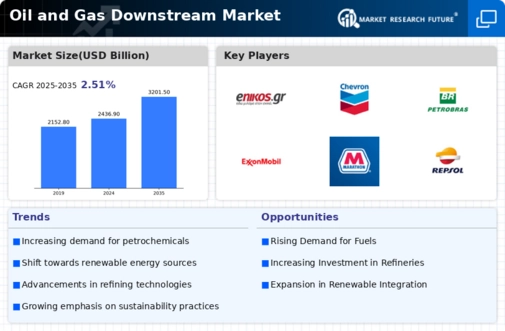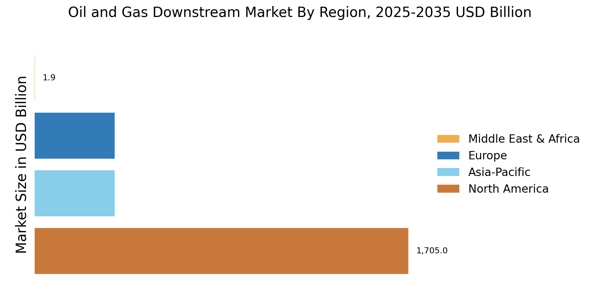Shifts in Energy Consumption Patterns
Shifts in energy consumption patterns are significantly impacting the Oil and Gas Downstream Market. As consumers increasingly prioritize renewable energy sources and electric vehicles, traditional fossil fuel consumption is undergoing transformation. This trend is prompting downstream companies to diversify their portfolios and invest in alternative energy solutions. For instance, the International Energy Agency has reported a gradual decline in gasoline demand in certain regions, compelling companies to adapt their strategies. While this shift poses challenges, it also opens avenues for innovation and the development of new products that align with changing consumer preferences.
Rising Demand for Petrochemical Products
The Oil and Gas Downstream Market is experiencing a notable increase in demand for petrochemical products, driven by various sectors such as automotive, construction, and consumer goods. The growth of these industries is propelling the need for derivatives like ethylene, propylene, and benzene, which are essential for manufacturing plastics and synthetic materials. Market data suggests that The Oil and Gas Downstream is projected to grow at a compound annual growth rate of approximately 5% over the next five years. This rising demand presents opportunities for downstream players to expand their product offerings and enhance profitability, thereby influencing overall market dynamics.
Geopolitical Factors and Supply Chain Dynamics
Geopolitical factors play a crucial role in shaping the Oil and Gas Downstream Market, influencing supply chain dynamics and market stability. Political tensions, trade disputes, and sanctions can disrupt supply chains, leading to fluctuations in crude oil prices and refining margins. For example, recent geopolitical events have resulted in increased volatility in oil prices, which directly affects downstream operations. Companies must navigate these complexities by developing robust risk management strategies and diversifying their supply sources. The ability to adapt to these geopolitical challenges is essential for maintaining competitiveness in an ever-evolving market landscape.
Technological Advancements in Refining Processes
Technological advancements are reshaping the Oil and Gas Downstream Market, particularly in refining processes. Innovations such as advanced catalytic cracking and hydrocracking technologies enhance the efficiency of crude oil conversion into valuable products. According to recent data, the adoption of these technologies can improve yield rates by up to 10%, significantly impacting profitability. Furthermore, automation and digitalization in refining operations are streamlining processes, reducing downtime, and optimizing resource allocation. As companies embrace these advancements, they are likely to enhance their competitive positioning in a market that demands efficiency and cost-effectiveness.
Regulatory Compliance and Environmental Standards
The Oil and Gas Downstream Market is increasingly influenced by stringent regulatory compliance and environmental standards. Governments worldwide are implementing more rigorous regulations aimed at reducing carbon emissions and promoting sustainable practices. This shift necessitates that companies invest in cleaner technologies and processes, which can lead to increased operational costs. For instance, the International Energy Agency has indicated that compliance with these regulations could require significant capital expenditures, potentially reaching billions of dollars annually. As a result, companies that proactively adapt to these regulations may gain a competitive edge, while those that fail to comply could face penalties and reputational damage.


















Leave a Comment